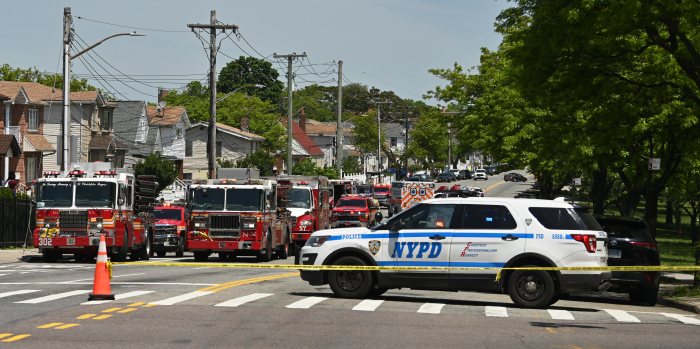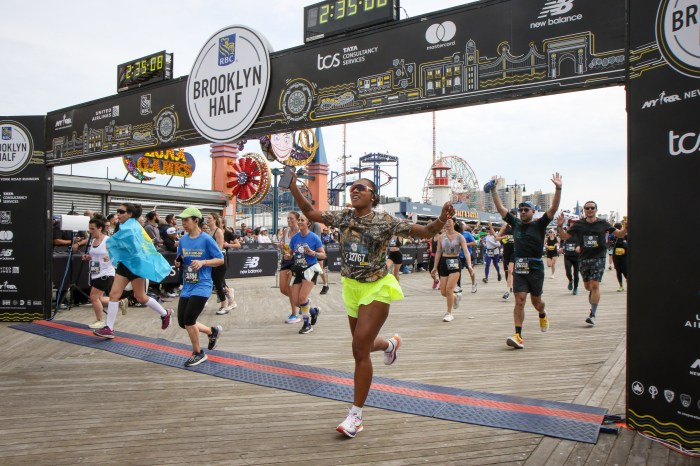By Ronda Kaysen
Downtown artist Andy Jurinko realized his work would never be the same after he witnessed the Sept. 11th attacks from his apartment directly across the street from the World Trade Center’s South tower. A lifelong baseball artist and author of “Heart of the Game,” an illustrated homage to the American League of the mid-20th century, you might say he threw in the bat on Sept. 12th. After he finished shoveling two feet of debris from his apartment, he was moved to find a new passion, but rehashing the violent demise of his 110-story neighbor and its political aftermath was not the kind of artistic expression he was looking for.
“I wanted to paint something beautiful,” he said. This quest for beauty is what led him to start painting… naked ladies.
“The prettiest thing in the world is a gorgeous woman!” he said, standing in his 125 Cedar St. studio beside a life-sized portrait of a topless Betty Page in pink panties and black stockings, wielding a red whip.
With a boyish smile and sad, wrinkled eyes, 65-year-old Jurinko likes to think of his glamour girls as “titillating” and, despite the recent publication of his first book of illustrations — a 12-year endeavor that was nearly derailed when the 650 transparencies for the book were buried in his studio beneath a mountain of ash and debris — looks forward to eventually showing his new, more scandalous work. “Everyone knows me as a baseball guy,” he said. “I’m trying to get a new identity.”
Jurinko began painting about baseball in 1986. Focusing on his childhood years, the mid-1940s to early 1960s, he captured a post-war era when baseball enjoyed a resurgence in the American consciousness and was not yet corrupted by money (“It gnaws at their souls,” he said of the players’ uncapped salaries). Now a reluctant Yankee fan, Jurinko grew up a Phillies fan in Philipsburg, New Jersey. A full-time artist since 1983, Jurinko found a niche with his action stills and bittersweet portraits of baseball greats. “Baseball is something everybody can relate to,” he said. “What’s more American than baseball?”
His wife, Patricia Moore, disagrees. She prefers the pinup girls. “She thinks I’m slightly crazed,” he said. “She hates baseball.” A portrait of her from 1985, in a white swimsuit and black-framed glasses, hangs in their modern living room.
His fans include Roland Betts, a board member of the Lower Manhattan development Corp. founder and chairperson of Chelsea Piers, and Ray Robinson, the 86-year-old baseball writer and former editor of Seventeen magazine. Betts, who owned the Texas Rangers with George W. Bush, purchased Jurinko’s famous still of Jackie Robinson sliding into base and gave the artist a show at his Santa Fe Gallery. At one point, some of Jurinko’s paintings hung in Mickey Mantle’s restaurant in Midtown. Three sold for $25,000. “Those were the days,” he said.
He eventually sold every one of the original 600 baseball paintings. “The one thing the baseball project taught me is to zero in on something,” he said, which is what led him to his latest project: the pinup girls.
He began painting the nudes in a tiny rental studio on Greenwich St. in North Tribeca while he and Moore were living in an interim apartment in Brooklyn Heights, restoring their shattered apartment by day. “I got this little 400 square foot studio for the same amount of rent as this place,” he said of his 1,800 square foot loft that he and Moore have shared since 1978. It was Moore, a sweater designer, who encouraged him to rent a studio and begin painting again. “I felt like a stranger in my own body,” he said of that time. “It was very schizophrenic.”
It took the couple 16 months and more than $35,000 to restore their apartment to its original condition. “We lost basically everything that we owned,” he said. “Twenty-four years of our life was in here.”
He also lost six months worth of paintings. “That was the end of that chapter,” he said.
Sept. 11th was the second time Jurinko had completely restored his apartment. When he found it through an ad in the Village Voice in 1977, it was a shell of an office building, abandoned five years earlier and in need of a complete renovation. “It looked like it had been bombed out in World War II,” he said. But the 12-foot ceilings and bank of 16 windows struck his fancy. “I thought this might be interesting,” he said. He signed a 15-year lease for $375 a month and got to work.
Moore, at the time a recent transplant from Houston, Texas, lived upstairs. “The place was like a clubhouse,” he said of the 12-story building. In 1978, Moore and Jurinko moved in together. They married 14 years later. “We built this place together,” he said. In 1977, the World Trade Center was still young, and Battery Park City was still only grass and beach. “We drank wine on the old elevated West Side Highway and watched the sunset,” he said. “In those days, this really was a pioneer building.”
Jurinko had arrived in New York two years earlier, fresh back on the East Coast after an eleven-year stint in San Francisco that ended when his debut art show delivered him one sale—for $500. He returned to the East Coast in November of 1975 without any money and ready to “try out New York.” He never left. “New York drives you to tears half the time and then you start loving the place,” he said.
It was this love for New York—specifically Lower Manhattan—that kept him rooted to his Cedar St. apartment after 9/11. “Twenty-four years here, I became a snob,” he said.
Now, as the Lower Manhattan Development Corporation begins to dismantle the contaminated Deutsche Bank building, located directly outside his kitchen window, he is an old hand at all of this. “I don’t think it’s going to be as bad as digging up Liberty St. and Church St. was,” he said of the complete excavation of his two surrounding streets. “The steam shovels, the jack hammers, most of the time it isn’t as noisy as you think,” he said. “Human beings kind of get used to anything.”
WWW Downtown Express














